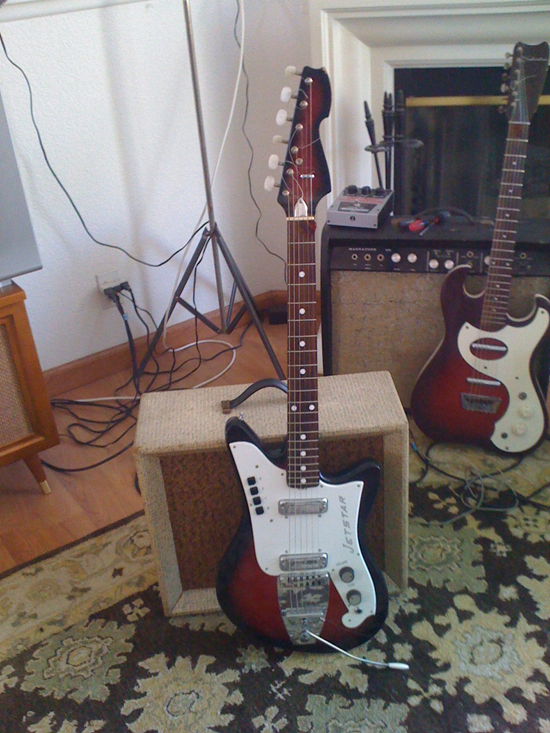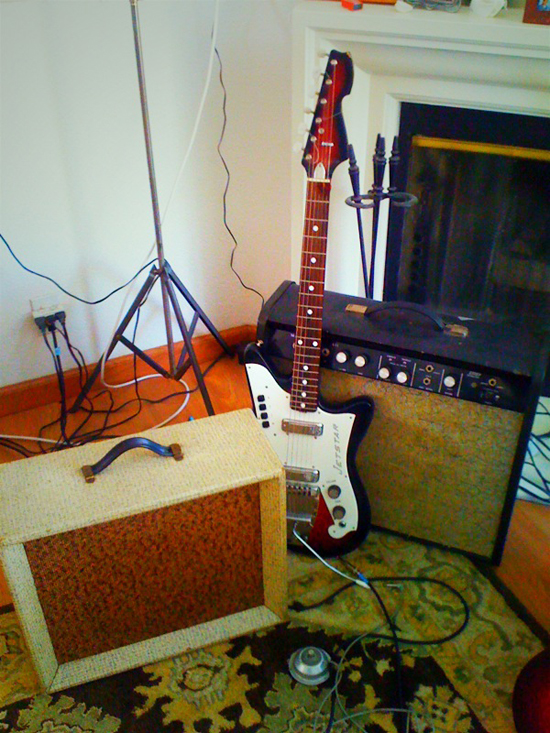A buddy of mine (thanks, Garrett!) tipped me to this model on eBay. I’ve long been a lover of 1960’s Italian-made guitars. One of my great regrets is letting go of a Sano hollowbody that was, in all but name, the same as the hollowbody Galanti Rangemaster.
What makes these guitars special? The necks, mostly. If you like think, very fast-playing necks, vintage Italian guitars may be your thing. This “Jetstar” model has the normal zippy neck, plus some other very cool feature—not the least of which are the (typical to Italian guitars made by factories more accustomed to cranking out accordions) push buttons for the pickup selectors.

1960’s Galanti Jetstar Electric Guitar
This model has a rather strange tone set-up. The buttons are labeled 0/1/2/M. You can either have the bridge pickup selected (setting 2), or the neck pickup (setting 1), or some cross between them that’s choked with a treble-cutting resistor (setting M). Or, you can hit the button closest to the strap on the treble horn (setting 0), which cuts the guitar off entirely (?!). Why anyone would need a kill switch on a guitar is beyond me. Unless you wanted to do that cool Morse-code sound at the end of “London Calling” (I may have answered my own question). But that Morse-code on/off only works with a toggle switch, not so well with a slower-to-operate button. But several 60’s Japanese and Italian models seem to have a button that turns everything off. Odd.
But the guitar plays like butter. Fast and slick—and the intonation is easy to set correctly. The bridge is pretty high-end, made very solidly with smooth slots and a center-loaded whammy bar with the feel and sweep of a Jazzmaster or Jaguar. And that’s who this guitar would probably appeal to the most—people who dig Jags and Jazzmasters, with a slightly more lo-fi, garage vibe to the tone. The tuners are high-end, as well—teardrop shaped with slightly pearloid plastic. Pretty.
And how is the tone? Like I say, very garage, very 60’s. Raw enough to play overdriven punk and grungy blues. The pickups sound a bit like a combination of a P-90 and a Teisco gold foil. Fair amount of snarl if you want it, but also full of some pretty cool surf tones if you want. For a single-coil guitar, there’s a good amount of sustain, too—plenty more than the Fenders mentioned here. The down-angle of the strings at the bridge eliminates the plinky lack of sustain that can plague a Jazzmaster (much as I love them). The tone is very balanced—overall, the guitar sits dead center in a midrange between the brightness of a Strat and the rich darkness of a Les Paul or 335.

1960’s Galanti Jetstar Electric Guitar
Put it together with the Magnatone 431(the one sitting behind the Danelectro in the pictures), and you have a great surf machine with some reverb and that wonderful Magnatone vibrato (OR tremolo, as this model Maggie has both choices—too cool). Plus it into the other amp pictured, the Lectrolab R600 (a truly amazing dual 6V6 amp that I’ll cover in a review soon), and it’s straight out 1950’s Chicago blues. Crank it up and you’re in Neil Young and Crazy Horse RAGGED GLORY territory. Really—play this through a fully-open overdriven amp and the tone is incredible.
The neck pickup is fat and rich, while the bridge has a fair amount of bite (less than a Jaguar or Strat—closer to the bridge PU of a Jazzmaster). The only thing that can be an issue (or it can be sonic joy, depending on who’s playing) is the pickups are very microphonic and the guitar can squeal feedback a little quicker than most solidbodies tend to do.
For anyone who’d be interested in buying a Jazzmaster, Jaguar or Mustang, you could do well (and save a few bucks in the process) grabbing one of these Galantis. They aren’t that easy to come by, but they aren’t super rare, either. Mine was beaten up and needed a neck repair, so I got a great deal on it (along with the original, form-fit case). But, if you’re looking to find a mint one, they seem to be out there in the $400-600 range as of this writing (Oct, 2010).
It’s not the MOST versatile machine you’ll add to your collection. But it sounds and plays great, and looks pretty fabulous, too. It’s become my number one guitar in my main garage/roots band. Really—plug it straight into a good amp and it sounds like you’re in a nice two-car garage in 1968, with mom and dad’s Falcon and Mustang (my family had cool cars) pulled out in the driveway. It’s not just a guitar—it’s a time machine!

I think that the reason they put those kill switches on the older guitars was for breaks and set ends…..the switch would cut out the chance of hum or feedback when a guitarist walked away from the stage. It also alleviated the stigma when you realize that your volume is off. one flick VS two twists of the volume dial as you drop your pick…..you know the story.
Hello ! great neck, best vintage smooth vibrato and easy-rolling bridge on earth, solid as a rock : Galanti surely did a great soulful rock n roll machine with the GrandPrix / Jetstar.. I have only one BIG question : what is your opinion or experience in bypassing the treble-cutting resistor that is activated in the M position ? many people at Harmony Central says it really ‘liberates’ the sound ? cheers from France ! great site ! — Renaud
Rob,
I like having an on/off switch on the guitar. You can use it like a standby switch on an amp to silence single-coil hum between tunes, or to prevent open string feedback while the guitar is at rest. I’ve often wondered why more guitars aren’t made this way.
Bill Ruxton
Millersville, MD
Nice Jetstar! Looks sweet. How about some sound samples?
Also, you seem to like old, smaller, less popular amps. I have a late 50s/early 60s Kay 503A in great condition available for sale if you are interested. Priced to sell at $200 plus shipping and it comes with a second set of NOS tubes. Contact me if you are interested. I can provide pictures.
Scott-
Is it too late to ask about that Kay 503A? If not, email me at robroberge@gmail.com. I’ve VERY interested 🙂
And thanks for the interesting defense of the kill switch. G;ad some people dig ’em.
About the ‘treble cut’, Mr. Kleach:P I tend to agree with the reviews at Harmony Central. Getting rid of that really “opens” up the sound. I’m not a big fan of treble-cutting caps in guitar tone circuits. But is IS a taste thing. I tend to get rid of the cap, though.
Scott–email me if it’s not too late!
Nice Jetstar! Looks sweet. How about some sound samples
Nice Jetstar! Looks sweet. How about some sound samples?
Also, you seem to like old, smaller, less popular amps. I have a late 50s/early 60s Kay 503A in great condition available for sale if you are interested. Priced to sell at $200 plus shipping and it comes with a second set of NOS tubes. Contact me if you are interested. I can provide pictures.
Sweet guitar! I have a similar guitar under the Goya name, the model name is a Panther and has three pickups that appear to be the same as on the Galanti. Also, the same body shape and “vegamatic” push-button switches. I enjoy the guitar very much. I used to have a Mustang and this guitar certainly beats it in intonation and playability!
Hi,
I’m looking for such a galanti. Could you refer me to a site or any adress please?
Thank you.
I don’t know of any place that sells Galanti, specifically. I’d say just check ebay with some regularity and you’ll find one.
As for sound samples–sorry, folks…but I can’t do those. All my recording equipment is tape/analog…so, I don’t really have a way to do digital files.
As for that Kay for sale, feel free to email me/send pics at: robroberge@gmail.com
Hi, I have a Galanti Hollowbody for sale. For spare parts, since the body has a crack at the bottum site of the guitar. You can see the crack and the guitar on youtube.
For example: http://gateway.marktplaats.nl/?url=http%3A%2F%2Fwww.youtube.com%2Fwatch%3Fv%3D56pO2YZqKPc
Technical the guitar is in great condition, neck, pickups, etcetera. But body is damaged (mostly the crack). If someone is interested he can mail me. The guitar is in Holland but can be shipped.
Thanks, Jan van der Brugge
Hello friends, fastidious post andd good urging commented here,
I am in faact enjoying by these.
It’s funny to find out how many blogs the internet has on this subject! I don’t know if I will ever need to come back here, but it is awesome to know I found the one that offers a lot of practical info if this ever comes up for me another time.
I have a galanti grand prix for sale, its all original no scratches or dings. A couple of fissures in the clear coat due to age but hardly noticable. Sunburst color, original case, all original parts in great shape. serial number 841
You want to sell it?